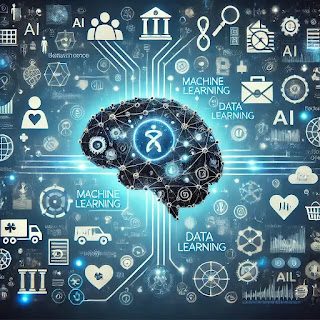Introduction: Machine Learning (ML) is one of the most exciting branches of Data Science. It enables computers to learn from data and make decisions or predictions without being explicitly programmed. Machine Learning is transforming industries by automating processes, improving accuracy, and discovering hidden patterns in data. In this post, we’ll dive into the role of machine learning, how it works, and why it’s essential for the future of data science.
1. What is Machine Learning?
Machine Learning is a subset of Artificial Intelligence (AI) that focuses on building systems that can learn from data and improve their performance over time. It uses algorithms to identify patterns in large datasets, allowing systems to make predictions or decisions based on new data.
How it Works:
- Training Data: Machine Learning models are trained on large datasets.
- Learning: The model learns patterns from this data using algorithms.
- Predictions: Once trained, the model can make predictions or decisions on new, unseen data.
2. Types of Machine Learning
Supervised Learning
In supervised learning, the model is trained on labeled data, which means the data has both inputs and the correct outputs. The algorithm learns from this data to predict outcomes for new inputs.
Example:
- Predicting house prices based on factors like location, size, and amenities.
Unsupervised Learning
In unsupervised learning, the model is trained on data without labeled outputs. The goal is to find hidden patterns or structures within the data.
Example:
- Grouping customers into segments based on purchasing behavior, without knowing their exact preferences in advance.
Reinforcement Learning
Reinforcement learning teaches machines to make sequences of decisions. The model interacts with an environment, learns from the results of its actions, and aims to maximize rewards.
Example:
- Self-driving cars learning to navigate through streets by making decisions on the go.
3. Machine Learning in Action
Healthcare
Machine Learning is used in healthcare to analyze medical records, predict diseases, and even personalize treatment plans. With enough data, machine learning models can detect patterns that humans might miss.
Example:
- Predicting patient outcomes based on their medical history and recommending preventive measures.
Finance
In finance, machine learning models analyze vast amounts of data to detect fraud, assess risks, and make investment decisions. This helps banks and financial institutions protect assets and optimize their services.
Example:
- Fraud detection systems that identify suspicious transactions by recognizing patterns that deviate from normal behavior.
Retail
Machine Learning helps retailers optimize pricing, predict demand, and personalize customer experiences. By analyzing past purchasing behavior, companies can predict future trends and offer personalized recommendations.
Example:
- E-commerce platforms like Amazon recommending products to users based on their browsing and purchase history.
4. The Future of Machine Learning in Data Science
Machine Learning is becoming more advanced with the rise of deep learning, a type of machine learning that mimics the way the human brain works. This technology will further improve the ability of machines to understand complex patterns, enhance decision-making, and automate tasks.
Key Areas of Growth:
- Automation: Machine Learning will continue to automate routine tasks, freeing up humans to focus on more creative and strategic work.
- Personalization: The use of data to deliver personalized experiences in industries like retail, entertainment, and healthcare will become more refined.
- Smart Systems: Machine Learning will power smarter systems, from self-driving cars to advanced virtual assistants that understand human emotions.
Conclusion:
Machine Learning is shaping the future of Data Science by providing powerful tools to analyze data, make predictions, and automate decision-making processes. Whether it's diagnosing diseases, preventing fraud, or offering personalized shopping experiences, machine learning plays a crucial role in revolutionizing industries. As technology advances, the applications of machine learning will only grow, making it a key driver of innovation in the world of Data Science.

Comments
Post a Comment